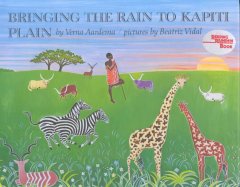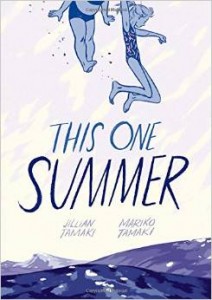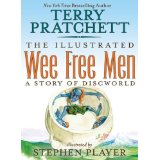The thing I really hope for my work, more than a particular recognition or financial return, is longevity. It’s one thing to craft a really great story that hits the imagination of the moment and becomes a blockbuster, but it’s an entirely different sort of success to have a book stand the test of time. This Reading Like a Writer post will be one in an occasional series which looks in depth at the text of children’s classics.
One of the things I did this summer was think about books I read to my own children when they were little, the ones they loved and wanted to hear over and over. A big favorite of theirs and mine was Bringing the Rain to Kapiti Plain by Verna Aardema and illustrated by Beatriz Vidal.  Though I love the pictures it’s the text that I really admire. Its been more than a decade since I’ve read that book aloud to one of my children but I can still recite it word for word. I decided to analyze for myself what made the story so effective. The obvious first thing is the rhyme scene which is perfect. Every rhyme is a true rhyme. The rhymed words are not forced by using archaic grammar They are all easy to read and well within a child’s working vocabulary.
Though I love the pictures it’s the text that I really admire. Its been more than a decade since I’ve read that book aloud to one of my children but I can still recite it word for word. I decided to analyze for myself what made the story so effective. The obvious first thing is the rhyme scene which is perfect. Every rhyme is a true rhyme. The rhymed words are not forced by using archaic grammar They are all easy to read and well within a child’s working vocabulary.
Rain–plain
dead–overhead
feather–weather
cloud–loud
The second fairly obvious observation is that the format of the story, the cumulative or House-that-Jack-Built format, works well for this tale in which each thing is directly related to the next. There is not a heap of tension in the story. It’s dry. Cows are hungry. The herdsman shoots an arrow at a cloud. It rains. Not inherently gripping, but the cumulative structure and rhythm of the text makes the simple chain of events far more compelling than they would be otherwise. However, the cumulative structure is not launched into willy-nilly at the start of the book. It begins with a 10 line introduction to set the scene and ends with a 4 line conclusion which brings the story to rest.
The third thing I looked at was how the lines scanned. How many syllables per line and where do the stressed words fall within the line. I found that all the lines fell between 8 and 12 syllables, and that the pattern of stresses tended to be anapestic, two unstressed syllables followed by a stressed one. However, there was plenty of variation in the meter. So the verses were less structured than, say a sonnet, but still they were quite consistent in their rhythms. I think a perfectly consistent rhythm would have veered in the direction of boring and singsongy text, so it’s good to see the “rules” judiciously broken.
The last thing I noticed was that almost the entire story relied on lines with a stressed ending.
This is the great Kapitit Plain
All fresh and green from the African rain.
Plain and rain are both stressed syllables and most of the book has these strong endings. But the story begins with a 10 line introduction and the middle 6 lines of the introduction have unstressed endings.
With acacia trees for giraffes to browse on
And grass for the herdsman to pasture the cows on.
The stressed syllables there are browse and cows, so the introduction is set apart from the story with this very subtle variation in the meter as well as being set apart from the structure of the main story.
So why do all this work? I love poetry. I think picture books in verse, when done well, have the best staying power of all. I hope to write one some day. But I want to make sure that when I do I put at least as much effort and attention to detail into the text as the writers like Verna Aardema and Margaret Wise Brown have.


